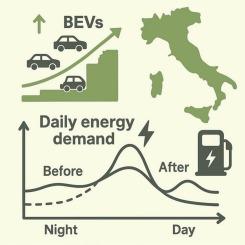Hourly energy demand impacts of battery electric vehicle adoption in Italy: A grid simulation and policy analysis
IF 5.9
Q2 ENERGY & FUELS
引用次数: 0
Abstract
The growing adoption of Battery Electric Vehicles (BEVs) poses significant challenges to electricity grids, especially in countries aiming for rapid decarbonization. This study evaluates the hourly impact of BEV integration on Italy’s energy system using a Python-based simulation model. Two scenarios are analyzed for 2024: (1) 3.5 million BEVs and (2) 7 million BEVs. The model incorporates hourly charging profiles for household and highway fast-charging, Italy’s renewable energy mix (solar, wind, hydro, bioenergy), and a 5 GWh battery energy storage system. Results show that Scenario 1 increases daily electricity demand by 19 % (to 1.1 TWh), with peak loads of 47–49 GW, requiring 152 GWh of thermal generation and emitting 76,000 tons of CO2 daily. Scenario 2 raises demand by 40 % (to 1.25 TWh), with peak loads of 50–53 GW, 224 GWh of thermal generation, and 112,000 tons of CO2 emissions. Existing storage mitigates 20 % of peak load but is insufficient for Scenario 2’s 15 GW shortfall. Key demand spikes occur at 01:00 and 11:00–18:00, coinciding with home and highway charging. Policy strategies such as time-of-use tariffs, expanding storage to 15 GWh, and doubling solar capacity could reduce emissions by up to 35 % and supply 80 % of BEV charging needs during daylight hours. This hourly-resolution analysis offers critical insights for grid planning and supports the EU’s Fit for 55 targets.

意大利电池电动汽车采用的小时能源需求影响:电网模拟和政策分析
电池电动汽车(BEVs)的日益普及对电网构成了重大挑战,特别是在旨在快速脱碳的国家。本研究使用基于python的仿真模型评估BEV集成对意大利能源系统的每小时影响。对2024年的两种情景进行了分析:(1)350万辆纯电动汽车和(2)700万辆纯电动汽车。该模型结合了家庭和高速公路快速充电的每小时充电配置文件,意大利的可再生能源组合(太阳能,风能,水能,生物能源)以及5gwh的电池储能系统。结果表明,情景1每日电力需求增加19%(达到1.1太瓦时),峰值负荷为47-49吉瓦,需要152吉瓦时的火力发电,每天排放76,000吨二氧化碳。方案2将需求提高40%(达到1.25太瓦时),峰值负荷为50-53吉瓦,热发电量为224吉瓦时,二氧化碳排放量为11.2万吨。现有储能可以缓解20%的峰值负荷,但不足以满足方案2的15吉瓦缺口。关键需求高峰出现在01:00和11:00-18:00,与家庭和高速公路收费一致。诸如分时电价、将储能容量扩大到15千兆瓦时以及将太阳能容量翻倍等政策策略可以减少高达35%的排放,并在白天提供80%的纯电动汽车充电需求。这种小时分辨率分析为电网规划提供了关键见解,并支持欧盟的“Fit for 55”目标。
本文章由计算机程序翻译,如有差异,请以英文原文为准。
求助全文
约1分钟内获得全文
求助全文
来源期刊

Renewable Energy Focus
Renewable Energy, Sustainability and the Environment
CiteScore
7.10
自引率
8.30%
发文量
0
审稿时长
48 days
 求助内容:
求助内容: 应助结果提醒方式:
应助结果提醒方式:


